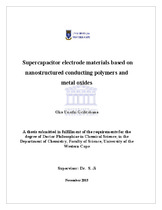| dc.description.abstract | Supercapacitors are charge-storage devices. Compared to batteries, they have higher power density, more excellent reversibility and longer cycle life. Therefore, supercapacitors have played an increasingly important role in the fields of power source especially in automotive applications, such as electric and hybrid electric vehicles. The higher power density of supercapacitors offers improved vehicle acceleration and the ability to recover more energy from regenerative breaking, since they can be charged and discharged at high current. Generally, the key for supercapacitors to achieve high specific power depends on the inherent properties and the surface areas of their electrode materials. Therefore, current research in the field of supercapacitors has been carried out with increased emphasis on the development of new electrode materials. Optimal novel synthesis of electrode materials for supercapacitor application in hybrid vehicles was accomplished with polypyrrole nanowires, manganese oxide and its carbon composites, ruthenium oxide and its carbon composites being the products. A set of structural and chemical parameters influencing the performance of synthesized electrode materials were identified. Parameters included crystallinity, particle size, particle size distribution, surface area, electrochemical activity. A large range of analytical tools were employed in characterizing the electrode materials of interest. High accuracy and precision in the quantitative and qualitative structural characterization of electrode materials collected by x-ray diffractometry, transmission electron microscopy, scanning electron microscopy and Fourier transform infra-red spectroscopy was demonstrated. N₂-physisorption produced surface area and pore size distribution data of high quality. Cyclic voltammetry, charge and discharge cycling, electron impedance spectroscopy were employed in the electrochemical characterization of the synthesized electrode materials and both qualitative and quantitative information obtained. The techniques were able to discriminate between various synthesized electrode materials and identify the highly electroactive materials. Preparation variables could be critically evaluated for the synthesis of electrode materials. The techniques were deemed to be applicable in discriminating high and low activity electrode materials based on their
structural and chemical properties. | en_US |

